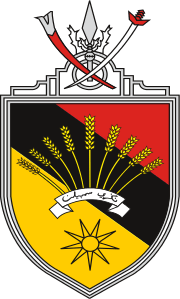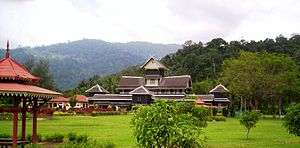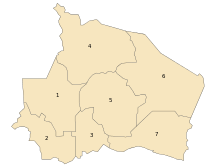Negeri Sembilan
Negeri Sembilan (Malay pronunciation: [ˈnəgəri səmbiˈlan]) is a state in Malaysia which lies on the western coast of Peninsular Malaysia. It borders Selangor on the north, Pahang in the east, and Melaka and Johor to the south.
Negeri Sembilan Nogoghi Smilan | |
|---|---|
| نݢري سمبيلن دار الخصوص Negeri Sembilan Darul Khusus | |
| Other transcription(s) | |
| • Chinese | 森美兰 (Simplified) 森美蘭 (Traditional) |
| • Tamil | நெகிரி செம்பிலான் |
 Flag  Coat of arms | |
| Anthem: Berkatlah Yang DiPertuan Besar Negeri Sembilan Bless the Great Ruler of Negeri Sembilan | |
 | |
| Coordinates: 2°45′N 102°15′E | |
| Capital | Seremban |
| Royal capital | Seri Menanti |
| Government | |
| • Type | Parliamentary constitutional elective monarchy |
| • Yang di-Pertuan Besar | Muhriz |
| • Menteri Besar | Aminuddin Harun (PH-PKR) |
| Area | |
| • Total | 6,686 km2 (2,581 sq mi) |
| Population (2015)[2] | |
| • Total | 1,098,500 |
| • Density | 160/km2 (430/sq mi) |
| Demonym(s) | Negeri Sembilanese Negri (i.e. "Negriwoman", "Negri folk" etc.) |
| Human Development Index | |
| • HDI (2010) | 0.795 (high) (6th) |
| Postal code | 70xxx to 73xxx |
| Calling code | 06 |
| Vehicle registration | N |
| Federated into FMS | 1895 |
| Japanese occupation | 1942 |
| Accession into the Federation of Malaya | 1948 |
| Independence as part of the Federation of Malaya | 31 August 1957 |
| Website | www |
The name is believed to derive from the nine (sembilan) villages or nagari in the Minangkabau language (now known as luak) settled by the Minangkabau, a people originally from West Sumatra (in present-day Indonesia). Minangkabau features are still visible today in traditional architecture and the dialect of Malay spoken.
Unlike the hereditary monarchs of the other royal Malay states, the ruler of Negeri Sembilan is known as Yang di-Pertuan Besar instead of Sultan. The election of the Ruler is also unique. He is selected by the council of Undangs who lead the four biggest territories of Sungai Ujong, Jelebu, Johol, and Rembau, making it one of the more democratic monarchies.
The capital of Negeri Sembilan is Seremban. The royal capital is Seri Menanti in Kuala Pilah District. Other important towns are Port Dickson, Bahau and Nilai.
The Arabic honorific title of the state is Darul Khusus ("the Special Abode").
History
The earliest inhabitants of Negeri Sembilan were the ancestors of the Semelai, Semai, Semang, and Jakun peoples, who lived either as hunter-gatherer nomads or as subsistence farmers.
The Minangkabaus from Sumatra settled in Negeri Sembilan in the 15th century (the 1400s) under the protection of the Malacca Sultanate, and later under the protection of its successor, the Sultanate of Johor. They also brought their matrilineal custom with them and made it a majority,[3][4] and the Linggi River was used as a main trade route since the time of the Malacca Sultanate.
As Johor weakened in the 18th century, attacks by the Bugis forced the Minangkabaus to seek protection from their homeland. The Minangkabau ruler, Sultan Abdul Jalil, obliged by sending his near relative, Raja Melewar. When he arrived, he found that another royal, Raja Khatib had already established himself as ruler. He declared war against Raja Khatib and became the ruler of Negeri Sembilan. The Sultan of Johor confirmed his position by granting the title Yamtuan Seri Menanti (He Who is Highest Lord of the Seri Menanti) in 1773. After Raja Melewar's death, a series of disputes arose over the succession. For a considerable period, the local nobles applied to the Minangkabau ruler in Sumatra for a ruler. However, competing interests supported different candidates, often resulting in instability and civil war.
In 1873, the British intervened militarily in a civil war in Sungai Ujong to preserve British economic interests, and placed the country under the control of a British Resident. Jelebu followed in 1886, and the remaining states in 1895. In 1897, when the Federated Malay States (FMS) was established, Sungai Ujong and Jelebu were reunited to the confederation of small states and the whole, under the old name of the Negeri Sembilan, was placed under a single Resident and became a member of the FMS.
The number of states within Negeri Sembilan has fluctuated over the years, the federation now consists of six states and a number of sub-states under their suzerainty. The former state of Naning was annexed to Malacca, Klang to Selangor, and Segamat to Johor.
Negeri Sembilan endured Japanese occupation in World War II between 1942 and 1945, joined the Federation of Malaya in 1948, and became a state of Malaysia in 1963.
Population and demographics
Negeri Sembilan has seven districts.
| Rank | Districts | Seat | Population 2015[5] |
|---|---|---|---|
| 1 | Seremban | Seremban | 620,100 |
| 2 | Port Dickson | Port Dickson | 119,300 |
| 3 | Jempol | Bandar Seri Jempol | 115,600 |
| 4 | Tampin | Tampin | 90,200 |
| 5 | Kuala Pilah | Kuala Pilah | 67,100 |
| 6 | Rembau | Rembau | 45,900 |
| 7 | Jelebu | Kuala Klawang | 40,300 |
| Total Population | 1,098,500 |
Negeri Sembilan has a collective population of 1,098,500 as of 2015;[2] the ethnic composition consisting of Malay 622,000 (56.6%) (mostly are Minangkabau descent), other Bumiputras 20,700 (1.9%), Chinese 234,300 (21.3%), Indian 154,000 (14%), Others 4,200 (0.4%), and Non Citizens 63,300 (5.8%).[2] The state has the highest percentage of Indians when compared to other Malaysian states.
Religion
According to the 2010 census, the population of Negeri Sembilan is 60.3% Muslim, 21.2% Buddhist, 13.4% Hindu, 2.4% Christian, 1.1% of unknown affiliation, 0.8% non-religious, 0.5% Taoist or Chinese religion follower, and 0.3% of followers of other religions.
Statistics from the 2010 Census indicate that 92.9% of the Chinese population in Negeri Sembilan are identified as Buddhists, with significant minorities of adherents identifying as Christians (3.6%), Chinese folk religions (1.9%) and Muslims (0.8%). The majority of the Indian population are Hindus (89.0%), with a significant minorities of numbers identifying as Christians (5.0%), Muslims (3.2%) and Buddhists (1.4%). The non-Malay bumiputera community are predominantly Atheists (39.7%), with significant minorities identifying as Christians (28.3%) and Muslims (20.2%). All Malays are Muslims.[7]
Languages
Negeri Sembilan is a multiethnic state in which every ethnic group speaks their own respective languages and dialects. The Negeri Sembilanese people speak a unique variety of Malay known as Negeri Sembilan Malay or in their native language as Baso Nogoghi. It is not closely related to other varieties of Malay in Peninsular Malaysia but more closely related with Malay varieties spoken in neighbouring Sumatra especially varieties of Minangkabau. Besides Malays, the Chinese community also speak their own languages and dialects. Orang Asli peoples like Temuans speak a language closely related to Malay. Standard Malay is widely used throughout the state.
Indians in Negeri Sembilan belong to various ethnicities. Tamil (Mother tongue to Indian Tamils and Ceylon Tamils) is used as a lingua franca among the other minor Indian communities. Many Malayalees can be found in Negeri Sembilan, predominantly in areas of Labu, Negeri Sembilan. This community speak Malayalam as their first language. Besides, small number of Telugu and Punjabi exist in the towns of Negeri Sembilan.
Government and politics
Constitution
The Constitution of Negeri Sembilan came into force on 26 March 1959. It is divided into two sections. The constitution establishes that the state's form of government is constitutional monarchy and the world's only elective monarchy for matrilineal society. The system was partially the basis for the federal monarchy.
The Ruler

The official constitutional title of the Ruler of the state are Duli Yang Maha Mulia Yang di-Pertuan Besar Negeri Sembilan, (currently Duli Yang Maha Mulia Yang di-Pertuan Besar Negeri Sembilan Darul Khusus Tuanku Muhriz ibni Almarhum Tuanku Munawir), Yang Teramat Mulia Undang of Sungei Ujong, Yang Teramat Mulia Undang of Jelebu, Yang Teramat Mulia Undang of Johol, Yang Teramat Mulia Undang of Rembau and Yang Teramat Mulia Tengku Besar Tampin and they holds office for life.
The state's constitution proclaims the Yang di-Pertuan Besar, Undang of Sungei Ujong, Undang of Jelebu, Undang of Johol, Undang of Rembau and Tengku Besar Tampin are vested with the Executive Power of the state, are the Head of the Religion of Islam in the state and are the fountain of all honour and dignity for the state. The current Yang di-Pertuan Besar is His Royal Highness Tuanku Muhriz ibni Almarhum Tuanku Munawir. His Royal Highness succeeds Almarhum Tuanku Jaafar Ibni Almarhum Tuanku Abdul Rahman who died on 27 December 2008.
Unlike Malaysia's eight other Royal Malay states, the Ruler of Negeri Sembilan is elected to his office by the territorial chiefs or Ruling Chiefs of the state. These Ruling Chiefs are titled Undang. Only four of the Undangs have the right to vote in the election for the Ruler of the State. They are:
- The Undang of Sungai Ujong
- The Undang of Jelebu
- The Undang of Johol
- The Undang of Rembau
The Undang themselves cannot stand for election and their choice of ruler is limited to a male Muslim who is Malay and also a "lawfully begotten descendant of Raja Radin ibni Raja Lenggang".
State Executive Council
The State Executive Council is established by the 1959 constitution. It consists of the Menteri Besar, who is its chairman, and ten other members. The Menteri Besar and the other members of the council are appointed by the Yang Di-Pertuan Besar from the members of the State Assembly. The current Menteri Besar or Chief Minister of the state is Aminuddin Harun.
 | |||||
| Affiliation | Coalition/Party Leader | Status | Seats | ||
|---|---|---|---|---|---|
| 2018 election | Current | ||||
| Pakatan Harapan | Aminuddin Harun | Government | 20 | 20 | |
| Perikatan Nasional | Mohamad Hassan | Opposition | 16 | 16 | |
| Total | 36 | 36 | |||
| Government majority | 4 | 4 | |||
Economy
The state's manufacturing sector contributes almost half of the state's gross domestic product (GDP), followed by services and tourism (40.3%), agriculture (6%), construction (2.2%) and mining (0.3%). Manufacturing activities include electrical supplies and electronics, textiles, furniture, chemicals, machinery, metal works and rubber products. The main industrial areas are Senawang, Sungai Gadut, Tuanku Jaafar Industrial Park, Nilai and Tanah Merah in Port Dickson. Coca-Cola weas scheduled to operate a 1-billion ringgit bottling plant in Bandar Enstek.
Negeri Sembilan is mainly an agricultural state. However, the establishment of several industrial estates enhanced the manufacturing sector as a major contributor towards the state economy.
Agricultural activity includes rubber and oil palm plantations, livestock, fruit orchards and vegetable farming. About 3,099 square kilometres are used for rubber and oil palm plantations.
Culture
The Minangkabau people brought along with them a cultural heritage which is still preserved and practised today as the Adat perpatih, a matrilineal system of inheritance and administration that is unique to the state. It is a system where the husband is the head of the household and inheritance passes from the mother to the daughter. The Minangkabau's divided into twelve suku or tribes, and marriage between members of the same tribe or clan is forbidden. The Minangkabau influence in the state can be found in dances and food as well.
Dances
Negeri Sembilan also has traditional music like the Caklempong, Dikir Rebana, Tumbuk Kalang, and Bongai.
The musical instruments used bear some semblance to Sumatra, the ancestral home of the Minangkabau people. Dances like the tarian lilin (candle dance) and rentak kuda (beat of the horse) are popular in Negeri Sembilan and the coordinated movements of the dancers in their colorful costumes in the Tarian Piring and the upbeat tempo of Tarian Randai. Unlike modern dance, each beat, rhythm and movement in these dances combines to form a story, maybe of a bygone myth or simply a reflection of the lifestyles of another era.
They are usually performed at traditional festivities, cultural events and dinner-cum-cultural shows.
Cuisine
Traditional Negeri Sembilan food is hot and spicy, as one of the ingredients used is the chili padi, the hottest of chili peppers. Popular dishes includes rendang, (pieces of beef cooked in coconut milk and chillies). One should experience the unique Minangkabau style of cooking, which sees generous portions of 'chili padi' (small and extremely hot chilies) being used. Try the "Masak Lemak Cili Padi - fish, meat, or vegetables cooked in coconut milk blended with turmeric and ground chili padi.The difference of "Masak Lemak Cili Padi" or the people often called it as "Gulai" in Negeri Sembilan with other state is there is no onions nor garlic used in making "Gulai".
Another Negeri Sembilan specialty is "Lemang", glutinous rice cooked in coconut milk in a bamboo stem over an open fire. This is normally served with Rendang, a deliciously thick and dry meat curry.[3]
Tourism
The popular attractions in Negeri Sembilan are:
- Galeri Diraja Tuanku Ja'afar - is a gallery in Seremban, Negeri Sembilan, Malaysia. The gallery is about the former Negeri Sembilan Yang di-Pertuan Besar Tuanku Ja'afar.
- Port Dickson Beach – A famous weekend retreat for city dwellers, said to have been named after British officer John Frederick Dickson in 1889[8]
- Seri Menanti Royal Museum – Originally a palace for the Negeri Sembilan Royal family until 1992, this five storey wooden palace was built using no nails or screws. The palace exhibits costumes, weaponry, bed chambers as well as documents on the royal lineage on display in the museum[9]
- Army Museum – exhibits artefacts in regards to the history of the Royal Malaysian Army.[10]
- Mount Datuk - This 884-metre peak provides a good work out and excellent views from the top. It is easily accessible via a day trip from Kuala Lumpur.
- Mount Angsi - Gunung Angsi is one of Malaysia's relatively mountains with a height of 2702 ft or 824m.It ranks 241st on my list of Malaysia's highest mountains and it is the 3rd highest peak in Negeri Sembilan state, after Gunung Datuk and Bukit Bintongan which are both slightly higher. It is even closer to Kuala Lumpur and is a popular climbing spot. It also similar height with Mount Datuk and quite an exhausting walk.
- Mount Telapak Buruk - One of the state's highest peaks though not so popular with day trippers.
- Lukut Fort and Museum - In Lukut, the tourists can wander among the hilltop remains of a 19th-century fort before visiting the neighbouring Lukut Museum which contains a Lukut Historical Gallery and other interesting artifacts.
- Penarikan Portage - the spot close to Bahau town is Jalan Penarikan where boats were carried over the short gap between eastbound and westbound rivers of the Malay Peninsula allowing movement between both coasts of the peninsular.
- Gemencheh Bridge (Sungai Kelamah) Memorial - This memorial marks the site of a battle at Gemencheh Bridge during World War II where Allied forces ambushed advancing Japanese troops. Many lives were lost here.
Administration

Districts
The state comprises 7 districts:
It originally consisted of 9 districts:
List of local authorities
There are 7 local authorities in Negeri Sembilan, namely:
- Majlis Bandaraya Seremban (MBS)
- Majlis Perbandaran Port Dickson (MPPD)
- Majlis Perbandaran Jempol (MPJL)
- Majlis Daerah Jelebu (MDJ)
- Majlis Daerah Kuala Pilah (MDKP)
- Majlis Daerah Rembau (MDR)
- Majlis Daerah Tampin (MDT)
Education
Negeri Sembilan has several tertiary education institutions. Most of these education institutions are concentrated in major towns in Negeri Sembilan. The list below represents public and private university based in Negeri Sembilan state:
Public universities
| Name | Acronym | Foundation | Location |
|---|---|---|---|
| Islamic Science University of Malaysia | USIM | 1998 | Nilai |
| Universiti Teknologi MARA | UiTM | 1999 | Kuala Pilah, Seremban & Rembau |
| Institut Pendidikan Guru Kampus Pendidikan Teknik | IPG KPT | 2013 | Bandar Enstek, Nilai |
Private universities and university colleges
| Name | Acronym | Foundation | Location |
|---|---|---|---|
| INTI International University | INTI-IU | 1998 | Nilai |
| Manipal International University | MIU | 2011 | Nilai |
| Nilai University | NU | 1997 | Nilai |
| Linton University College | UCL | 1995 | Mantin |
| Malaysia Theological Seminary | STM | 1979 | Seremban |
| UCSI International School | UCSI | 1986 | Bandar Springhill |
Hospitals
There are public hospitals and private hospitals in Negeri Sembilan:
Public Hospitals
- Hospital Tuanku Jaafar, Seremban
- Hospital Tuanku Ampuan Najihah, Kuala Pilah
- Hospital Port Dickson
- Hospital Tampin
- Hospital Jelebu
- Hospital Jempol
Private Hospitals
- Nilai Medical Center, Negeri Sembilan, Malaysia
- Seremban Specialist Hospital
- Columbia Asia Medical Center - Seremban
- Senawang Specialist Hospital
- NSCMH Medical Centre
- Columbia Asia Hospital
- Mawar Medical Centre
Media
Television

Television in Negeri Sembilan consists of seven free-to-air stations, and one satellite television network services. Three of the seven free-to-air stations are managed by Radio Televisyen Malaysia, a federal government-owned media company headquartered in Kuala Lumpur, while the four commercial stations are owned by Media Prima, an integrated media company headquartered in Bandar Utama, Selangor. The satellite television service is owned by Astro All Asia Networks and it is available nationwide.
- Free-to-air
- Radio Televisyen Malaysia (RTM)
- TV1
- TV2
- TVi
- TV Alhijrah
- Media Prima
- Satellite television
- Astro (All Astro Plc)
Newspaper
Mainstream newspapers in Negeri Sembilan are:
- Berita Harian (in Bahasa Malaysia)
- Utusan Malaysia (in Bahasa Malaysia)
- Kosmo! (in Bahasa Malaysia)
- Harian Metro (in Bahasa Malaysia)
- Sinar Harian (in Bahasa Malaysia)
- New Straits Times (in English)
- The Star (in English)
- The Malay Mail (in English)
- The Sun (in English)
- Nanyang Siang Pau (in Mandarin)
- Sin Chew Daily (in Mandarin)
- China Press (in Mandarin)
- Malaysia Nanban (in Tamil)
- Tamil Nesan (in Tamil)
- Makkal Osai (in Tamil)
See also
References
- "Laporan Kiraan Permulaan 2010". Jabatan Perangkaan Malaysia. p. 27. Archived from the original on 27 December 2010. Retrieved 24 January 2011.
- "Population by States and Ethnic Group". Department of Information, Ministry of Communications and Multimedia, Malaysia. 2015. Archived from the original on 12 February 2016. Retrieved 12 February 2015.
- http://go2travelmalaysia.com/tour_malaysia/ns_historical.htm
- https://museumvolunteersjmm.com/2016/04/04/the-minangkabau-of-negeri-sembilan/
- "Data Sosioekonomi Negeri Sembilan Tahun 2015" (PDF).
- "2010 Population and Housing Census of Malaysia" (PDF). Department of Statistics, Malaysia. Archived from the original (PDF) on 13 November 2013. Retrieved 17 June 2012. p. 13
- "2010 Population and Housing Census of Malaysia" (PDF) (in Malay and English). Department of Statistics, Malaysia. p. 87. Archived from the original (PDF) on 16 January 2013. Retrieved 17 June 2012.
- "Port Dickson Beach". Tourism Malaysia. Retrieved 21 May 2014.
- "Seri Menanti Royal Museum". Tourism Malaysia. Retrieved 21 May 2014.
- "Army Museum". Tourism Malaysia. Retrieved 22 May 2014.
External links
| Wikimedia Commons has media related to Negeri Sembilan. |
- Official site of Negeri Sembilan State Government
- Tourism Malaysia – Negeri Sembilan
- Negeri Sembilan travel guide written and maintained by locals